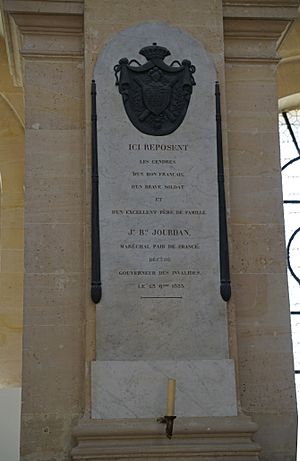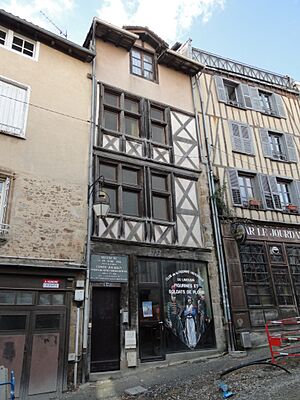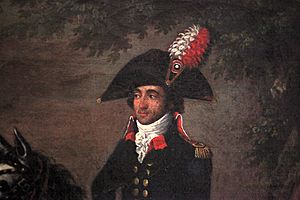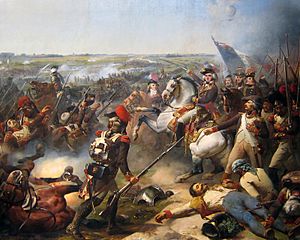Jean-Baptiste Jourdan facts for kids
Quick facts for kids
Marshal of the Empire
Jean-Baptiste Jourdan
|
|
|---|---|

Portrait as Marshal of the Empire, after the original by Joseph-Marie Vien painted c. 1805
|
|
| Nickname(s) | The victor of Fleurus |
| Born | 29 April 1762 Limoges, France |
| Died | 23 November 1833 (aged 71) Paris, France |
| Allegiance | |
| Service/ |
Army |
| Years of service | 1778–1815 |
| Rank | Marshal of the Empire |
| Battles/wars |
See list:
American Revolutionary War
|
| Awards | Grand Cross of the Legion of Honour Grand Cross of the Order of Saint Hubert Grand Dignitary of the Royal Order of the Two-Sicilies Knight of the Order of Saint Louis Knight of the Order of the Holy Spirit |
| Other work | Deputy in the Council of Five Hundred Governor of Les Invalides (1830–1833) |
| Signature | |
Jean-Baptiste Jourdan (born April 29, 1762 – died November 23, 1833) was a famous French military leader. He fought in the French Revolutionary Wars and the Napoleonic Wars. In 1804, Emperor Napoleon I made him a Marshal of the Empire, which was a very high military rank.
Jourdan was known as one of the most successful commanders of the French Revolutionary Army. He is especially remembered for leading France to a big win at the Battle of Fleurus. Later, under Napoleon's rule, he continued to serve in the army. However, he faced a major defeat at the Battle of Vitoria, which led to France losing control of Spain. After Napoleon, Jourdan supported the return of the French kings (the Bourbon Restoration). He later also supported the July Revolution and spent his last years as the governor of the Hôtel des Invalides, a famous home for veterans in Paris.
Contents
Early Life and Army Start
Jean-Baptiste Jourdan was born in Limoges, France, on April 29, 1762. He was the only child of a surgeon. His mother passed away when he was only two years old. He was then raised by his uncle, a priest who ran a school. When Jourdan was nine, his father also died, leaving him an orphan with no money.
After finishing school, Jourdan worked for about a year as an apprentice in a clothing shop in Lyon. At 15, in 1778, he decided to join the Royal army. His regiment was sent to fight in the American War of Independence.
Fighting in America
Jourdan's first battle was at the capture of Granada in 1779. A few months later, he took part in the difficult Siege of Savannah in October 1779. For the next few years, he served in the West Indies. He helped defend the island of Saint Vincent in 1780 and was part of the invasion of Tobago in 1781.
During his time in the West Indies, Jourdan became very sick. This illness caused him problems for the rest of his military life. Because of his poor health, he missed most of the battles in 1782. In 1784, he left the Royal army. He returned to Limoges, where he found work and got married in 1788. He and his wife had six children.
Rise During the French Revolution
Jourdan was very excited about the French Revolution. In 1790, he became a lieutenant in the National Guard. When the French government asked for volunteers, Jourdan was chosen to lead a battalion of volunteers from his home area.
He led his troops to victory at the Battle of Jemappes in November 1792. His leadership skills were noticed, and he was quickly promoted to Brigade general in May 1793, and then to general of division two months later. In September, he was wounded in the chest at the Battle of Hondschoote. Soon after, he was put in charge of the Army of the North.
One of Jourdan's first big tasks was to help the French soldiers trapped in Maubeuge. He defeated the Austrian-Dutch army at the Battle of Wattignies in October 1793, breaking the siege.
In early 1794, Jourdan was briefly removed from the army for refusing an order he thought was impossible. However, he was soon called back to lead the Army of the Moselle. This army later became the Army of Sambre-et-Meuse.
Victory at Fleurus
In June 1794, Jourdan led his 70,000 soldiers to besiege Charleroi. An Austrian-Dutch army tried to stop him but failed. Charleroi surrendered on June 25. The very next day, a larger Allied army attacked Jourdan's forces at the Battle of Fleurus.
Even though the Allied attacks pushed back parts of his army, Jourdan bravely kept fighting. His army held its ground and won a very important victory. This battle was a turning point. After Fleurus, the Allied forces had to leave Belgium, and the French army advanced into the Dutch Republic.
Later in 1796, Jourdan led his army into Bavaria. The plan was for all French armies to advance towards Vienna. However, the Austrian army, led by Archduke Charles, managed to defeat Jourdan at the Battle of Amberg and the Battle of Würzburg. Jourdan's army was forced to retreat. Because of these defeats, Jourdan was not given another command for two years. During this time, he became a politician and helped create a famous law in 1798 that made military service required for all young men. This was known as the Jourdan law.
Later Wars and Political Life
When war started again in 1799, Jourdan was put in charge of the army on the Rhine. But he was again defeated by Archduke Charles at the battles of Ostrach and Stockach. Feeling unwell and disappointed, he gave up his command.
He went back to politics and opposed Napoleon's rise to power in 1799. However, he later made peace with Napoleon and accepted new military and government jobs. In 1804, Napoleon made him a Marshal of the Empire.
Jourdan served in the Kingdom of Italy and then became a military advisor to Joseph Bonaparte, Napoleon's brother, who became King of Naples and later King of Spain. In Spain, other French marshals often ignored Jourdan. He was blamed for the defeat at the Battle of Talavera in 1809.
In 1811, he became Joseph's chief of staff again. However, after a big French defeat at the Battle of Salamanca in 1812, Joseph and Jourdan had to leave Madrid. In 1813, Wellington's army attacked the French at the Battle of Vitoria. This was a major defeat for France, and Jourdan's marshal's baton (a symbol of his rank) was captured by the British. After this, France permanently lost Spain.
Life After the Wars
Jourdan accepted the return of the French kings in 1814. When Napoleon briefly returned to power in 1815, Jourdan joined him. But after Napoleon's final defeat at the Battle of Waterloo, Jourdan again supported the kings.
He was made a count and a Peer of France in 1819. He also became governor of Grenoble in 1816. In politics, Jourdan was against those who wanted to bring back the old royal system. He supported the July Revolution of 1830, which brought a new king to power. After this, he served as the governor of the Hôtel des Invalides in Paris, a job he held until he died.

Jean-Baptiste Jourdan died in Paris on November 23, 1833, and was buried at Les Invalides. Even Napoleon, who had sometimes treated Jourdan unfairly, later said that Jourdan was a "true patriot."
Jourdan also wrote books about his military campaigns and his personal memories.
See also
 In Spanish: Jean-Baptiste Jourdan para niños
In Spanish: Jean-Baptiste Jourdan para niños




